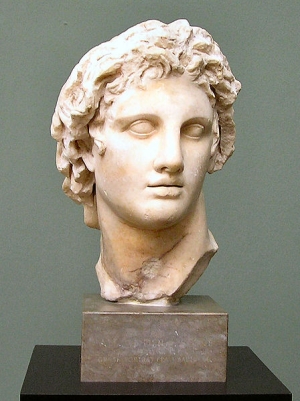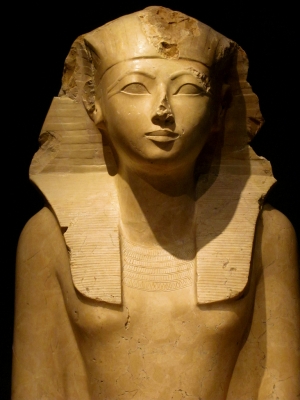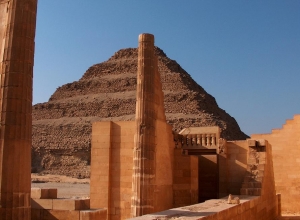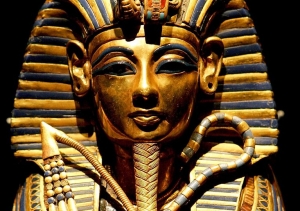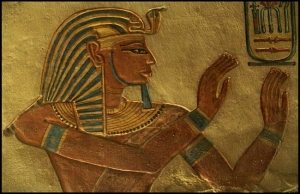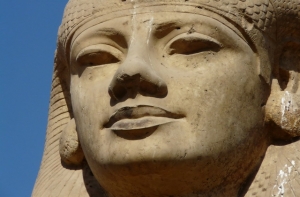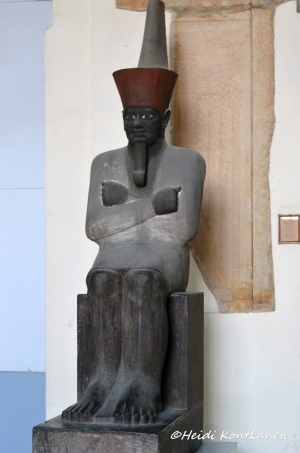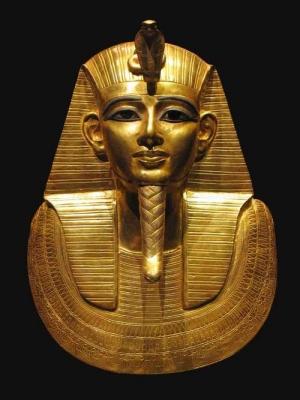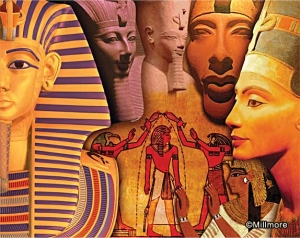+2 0122-345-3028
This email address is being protected from spambots. You need JavaScript enabled to view it.
Super User
Alexander the Great
Alexander the Great
Alexander the Great was an ancient Macedonian ruler and one of history’s greatest military minds who—as King of Macedonia and Persia
established the largest empire the ancient world had ever seen. By turns charismatic and ruthless, brilliant and power hungry, diplomatic and bloodthirsty, Alexander inspired such loyalty in his men they’d follow him anywhere and, if necessary, die in the process. Though Alexander the Great died before realizing his dream of uniting a new realm, his influence on Greek and Asian culture was so profound it inspired a new historical epoch—the Hellenistic Period.
Alexander III of Macedon, known as Alexander the Great (21 July 356 BCE – 10 or 11 June 323 BCE), was the son of King Philip II of Macedon. He became king upon his father’s death in 336 BCE and went on to conquer most of the known world of his day. He is known as 'the great' both for his military genius and his diplomatic skills in handling the various populaces of the regions he conquered. He is further recognized for spreading Greek culture, language, and thought from Greece throughout Asia Minor, Egypt, and Mesopotamia to India and thus initiating the era of the "Hellenistic World".
Queen Hatshepsut
Queen Hatshepsut
Queen Hatshepsut was a pharaoh from the 18th Dynasty, she was one of the powerful ancient Egypt pharaohs ruled Egypt during the New Kingdom, and the first woman who ruled Egypt When her husband (Thutmose II) died because his son (Thutmose III) was a young child. She began her rule as his regent but she became the pharaoh. She claimed to be the child of AMON and transformed herself into a king by wearing the symbols of kingship.
Queen Hatshepsut extended Egyptian trade and oversaw ambitious building projects, most notably the Temple of Deir el-Bahri, which you can visit during your Egypt vacation it’s located in western Thebes, where she would be buried.
King Zoser
King Zoser {Djoser}
King Djoser is the builder of the 1st pyramid in Egypt which is The Step Pyramid in Saqarra as a part of his funerary complex during the 3rd dynasty, so start your Egypt tours by visiting his pyramid at Saqarra complex he has also a limestone statue located on the 1st floor at the Egyptian Museum in Cairo and consider one of the masters pieces of the Museum because it’s the 1st life-size statue in ancient Egypt.
King Tutankhamun
King Tutankhamun
King Tutankhamun was the youngest ancient Egypt pharaohs who ruled Egypt from the 18th Dynasty, during the New Kingdom, and he is the best-known pharaoh today. He was the son of Akhenaten and became pharaoh at the age of nine. During the first year of his reign, Tutankhamun left Amarna and restored the cults of the old deities. His regent was Horemheb who was a senior military official.
King Tutankhamun restored the power of Thebes and died after around ten years of rule. Later scribes excluded his name from many of the kings’ lists and people forgot his rule. For this reason, tomb-robbers never found his tomb in the Valley of the Kings. His treasures and his body have been found at The Valley of The Kings in the 1920 and now all his treasures except the mummy have been transferred to the Egyptian Museum in Cairo which you can visit during your Egypt Holiday Packages to see the golden collection of the young pharaoh.
King Ramses 3rd
King Ramses 3rd
King Ramses 3rd was a ruler from the 20th Dynasty of the New Kingdom and records show that he was not a relative of the previous Ramses. After Twosret’s death, there was a period of lawlessness that Sethnakht, Ramses 3rd’s father, ended. He had to fight various invaders trying to take advantage of Egypt’s internal turmoil. He built a mortuary temple in the Theban Necropolis and various other buildings.
He reorganized the temple administrations and land allocations. By the end of Ramses 3rd’s thirty-one-year reign, one-third of the farmland belonging to the temples.
This caused food shortages and led to one of the first recorded strikes of the workers at Deir el-Medina. It also led to a weakening in the power of the pharaoh and the central government.
The previous kings had mentioned were the most famous and important kings who had a great influence on the Egyptian history and civilization.
It’s important to mention also that the descent of kingship was usually from father to son but the role of mothers and queens was equally important because the successor was a son of the king by the chief royal wife. During the Egyptian history the role of the queen as the mother of the king and a symbol of the power creation and rebirth.
Ahmose I
Ahmose (Nebpehtyre) 1539 – 1514 BC
Ahmose I,
The Founder of the 18th Dynasty and the New Kingdom of Ancient Egypt
Egypt's 18th Dynasty that established the New Kingdom is, to most people interested in Egypt, a dynasty of stars. It is the dynasty of Tutankhamen who was a fairly minor king, but perhaps the best known of any of the pharaohs. It was also the dynasty of the well known Akhenaton, and of Queen Hatshepsut.
The founder of this Dynasty is less well known to the general public, but unquestionably of major importance to Egyptian history. He was Ahmose I, during who's reign Egypt was finally and completely liberated from the Hyksos. Various scholars attribute different dates to his reign, but he probably became ruler of Egypt around 1550 BC at the age of 10, and ruled for a period of around 25 years before his death (examination of his well preserved mummy suggest he was about 35 when he died).
Ahmose I (Amosis to the Greeks) was given the birth name Ah-mose (The Moon is Born). His thrown name was Neb-pehty-re (The Lord of Strength is Re). He was probably a boy when he assumed the thrown, having lost his father Seqenenre Taa II and his brother Kahmose within three years of each other. His mother was Queen Ashotep, a powerful woman who was perhaps his co-regent during his early years.
Egyptologists believe that during his very early reign, little was probably accomplished and perhaps the Hyksos may have even gained some ground, recapturing Heliopolis. However, by the end of his first decade in power, we know from an Autobiography of Ahmose, son of Ibana, a naval officer from El-Kab, that he laid siege on Avaris (The tomb of Ahmose Pennekheb, another soldier also records the campaigns). This was a long battle interrupted by the need to put down insurrections in already liberated territories, but appears to have been successful sometime between his 12th and 15th year as ruler. Afterwards, he attacked the southwest Palestinian fortress of Sharuhen in a six year siege that would finally put an end to Hyksos control of Egypt.
Ahmose I's Battle Ax
Apparently, while Ahmose I was in Nubia, former Hyksos allies again attempted a few uprising in the north lead by an arch enemy of Kamose named Teti-en. In this instance, Ahmose I's mother, Ahhotpe, was probably responsible for putting down the rebellion and for this she was awarded the gold flies, an award for valor that was found on her mummy in her intact tomb at Thebes.
After Ahmose I's campaigns in Nubia, he once again returned to Palestine during his 22nd year in power and may have fought his way as for as the Euphrates, according to information on a stela of Tuthmosis I.
Ahmose I married his sister, Ahmose-Nefertiri, who became Egypt's first great God's Wife of Amun, and had a number of children including:
Merytamun - eldest daughter of Ahmose-Nefertari (died young)
Tair - daughter of Kasmut
Satamun - 2nd daughter of Ahmose-Nefertari (died infant)
Sapair - eldest son of Ahmose-Nefertari (died young)
Saamen - 2nd son of Ahmose-Nefertari (died infant)
Aahotep - 3rd daughter of Ahmose-Nefertari (Queen)
Amenhotep I - 3rd son of Ahmose-Nefertari (King)
Satkames - 4th daughter of Ahmose-Nefertari (died aged 30)
Henttameh- daughter of Thenthapi
Ahmose - daughter
We also know from Ahmose, son of Ibana that he supported his reign and rewarded local princes who had supported the Theban cause during the Second Intermediate Period by gifts of land (as recorded in Ahmose, son of Ibana's tomb at el-Kab). We also know that he initiated some temple building projects, notably at Abydos. However, though we know he reopened the Tura limestone quarries, little survives of his construction apart form a few additions to the temples of Amun and Montu at Karnak. However, a recent Dutch-Egyptian team of archaeologists believe they may have unearthed the remains of Ahmose's palace in the Al-Dabaa area in the Sharqiya Governorate of Egypt, a location that was probably the ancient Hyksos capital.
Pyramid of Ahmose I
He was buried in the Dra Abu el-Naga area, but his tomb has yet to be found. His actual mummy was found in the Deir el-Bahari cache. He did have a cenotaph at South Abydos, consisting of a cliff temple and a pyramid and temple on the edge of the Nile valley. The pyramid which measures about 70 meters square is the last known royal example built in Egypt. Some battle scene decorations within the pyramid may have depicted his wars with the Hyksos. In these scenes are some of the earliest representation of horses in Egypt.
Mentu hotep ll
Mentu hotep ll
Mentuhotep II, also called Nebhapetre, king (ruled 2008–1957 bce) of ancient Egypt’s 11th dynasty (2081–1938 bce) who, starting as the ruler of southernmost Egypt in about 2008 bce, reunified the country by defeating his rivals and ushered in the period known as the Middle Kingdom (1938–c. 1630 bce).
At his accession, Mentuhotep controlled Upper Egypt from Aswān to This, an ancient city about 90 miles (145 km) north of Thebes, his capital. He inherited a realm that had already spent some 60 years in intermittent warfare with the Heracleopolitan kingdom, which ruled Middle and Lower Egypt, as each state sought to control the whole country.
In the 14th year of his reign, Mentuhotep launched a drive against Heracleopolis. Nothing is known of the course of the war, but the Thebans were aided by a change of rulers in the enemy capital, and, by 1968 at the latest, Mentuhotep had captured Heracleopolis and reunited Egypt. In subsequent years, fighting continued in the north and against the Bedouin, who habitually raided the delta. Northern Nubia was annexed later in the reign. To consolidate the unification, Mentuhotep received the submission of Middle Egypt’s local governors, most of whom he left in office, thereby establishing a series of powerful provincial families during the early Middle Kingdom. Thebes became the national capital, and Mentuhotep’s loyal supporters received the key government posts; he also accepted partisans of the defeated Heracleopolitans who demonstrated loyalty to the new order.
Reunification was followed by great expansion in trade and building. Mentuhotep built temples at numerous Upper Egyptian sites, but little survives of them. At Thebes he built a magnificent temple and tomb complex. The hills around the monument were honeycombed with the tombs of his officials. He died about 1957, leaving a reunited and prosperous kingdom to his successor, Sankhkare Mentuhotep III. Tradition accorded Mentuhotep II an honoured place with Egypt’s other unifiers, the founders of the 1st (c. 2925–c. 2775 bce) and 18th dynasties.
King Narmer 3200 BC
King Narmer 3200 BC
Narmer (c. 3150 BCE) was the first king of Egypt who unified the country peacefully at the beginning of the First Dynastic Period (c. 3150 - 2613 BCE). He has also, however, been cited as the last king of the Predynastic Period (c. 6000 - 3150 BCE) before the rise of a king named Menes who unified the country through conquest. In the early days of Egyptology these kings were considered to be two different men. Narmer was thought to have attempted unification at the end of one period and Menes to have succeeded him, beginning the next era in Egyptian history.
This theory became increasingly problematic as time went by and little archaeological evidence supported Menes' existence while Narmer was well attested to in the archaeological record. The great Egyptologist Flinders Petrie (1853 - 1942 CE) claimed Narmer and Menes as the first pharaoh of the First Dynasty in that the two names designated one man: Narmer was his name and Menes an honorific.
This same understanding holds for the other pharaoh associated with Menes, Hor-Aha (c. 3100 BCE), the second king of the First Dynasty who is also said to have united Egypt under central rule. If Hor-Aha was the ruler who achieved unification of Upper and Lower Egypt, then `Menes' was simply his honorific, meaning "he who endures". Some scholars claim there is no reason to argue over which of these kings may have united Egypt as the country wasn't truly united until the reign of Khasekhemwy (c. 2680 BCE), last king of the Second Dynasty and father of the king Djoser who began the Third Dynasty. This claim has been repeatedly challenged, however, since there is clear evidence of the king Den (c. 2990-2940 BCE) wearing the crown of Upper and Lower Egypt, indicating unification under his reign. More significantly, the Narmer Palette (an ancient inscribed slab of siltstone) just as clearly shows Narmer wearing the war crown of Upper Egypt and the red wicker crown of Lower Egypt and so it is generally accepted that unification first took place under the reign of the king Narmer.
List of Rulers of Egypt
List of Rulers of Egypt throughout History
N.B. Dates of Pharaonic Era is adopted from Baines and Málek, Atlas of Ancient Egypt, Oxford, 1988
|
Ruler Pharaonic Era 1st Dynasty |
Narmer/Menes c. 3200-2920 - ?
Aha ? - ?
Djer ? - ?
Djet (Wadj) ? - ?
Den ? - ?
Anedjib ? - ?
Semerkhet ? - ?
Qa'a ? - ?
|
Ruler Pharaonic Era 2nd Dynasty |
Hotepsekhemwy c. 2770 - ?
Reneb ? - ?
Ninetjer ? - ?
Seth-Peribsen ? - ?
Khasekhemwy ? - ?
|
Ruler Pharaonic Era 3rd Dynasty |
Sanakhte (Nebka) 2649 - 2630
Djoser (Netjerykhet) 2630 - 2611
Sekhemkhet 2611 - 2603
Khaba 2603 - 2599
Huni 2599 - 2575
|
Ruler Pharaonic Era 4th Dynasty |
Snefru 2575 - 2551
Khufu (Cheops) 2551 - 2528
Radjedef (Djedefre) 2528 - 2520
Khafre (Chephren) 2520 - 2494
Menkaure' (Mycerinus) 2490 - 2472
Shepseskaf 2472 - 2467
|
Ruler Pharaonic Era 5th Dynasty |
Userkaf 2465 - 2458
Sahure 2458 - 2446
Neferirkare Kakai 2446 - 2426
Shepseskare 2426 - 2419
Raneferef (a.k.a. Neferefre) 2419 - 2416
Niuserre (Ini) 2416 - 2392
Menkauhor 2396 - 2388
Djedkare (Isesi) 2388 - 2356
Wenis (Unas) 2356 - 2323
|
Ruler Pharaonic Era 6th Dynasty |
Teti 2323 - 2291
Pepi I (Meryre) 2289 - 2255
Merenre (Nemtyemzaf) 2255 - 2246
Pepi II (Neferkare) 2246 - 2152
|
Ruler Pharaonic Era 7-8th Dynasty |
Numerous ephemeral kings, including Neferkare' 2150 - 2134
|
Ruler Pharaonic Era 9-10th Dynasty |
Several kings called Khety; Merykare' and Ity 2134 - 2040
|
Ruler Pharaonic Era 11th Dynasty |
Inyotef I (Sehertawy) 2134 - 2118
Inyotef II (Wahankh) 2118 - 2069
Inyotef III (Nakhtnebtepnefer) 2069 - 2061
Montuhotep I 2061 - 2010
Montuhotep II 2010 - 1998
Montuhotep III 1998 - 1991
|
Ruler Pharaonic Era 12th Dynasty |
Amenemhat I (Ammenemes) 1991 - 1962
Senwosret I (Sesostris) 1971 - 1926
Amenemhat II 1929 - 1892
Senwosret II 1897 - 1878
Senwosret III 1878 - 1841?
Amenemhat III 1844 - 1797
Amenemhat IV 1799 - 1787
Nefrusobek (Sobeknefru, Sobekkare) (fem.) 1787 - 1783
|
Ruler Pharaonic Era 13th Dynasty |
About 70 kings in chaotic period 1783 - 1640
|
Ruler Pharaonic Era 14th Dynasty |
Nehesy ? - ?
|
Ruler Pharaonic Era 15th Dynasty |
Salitis (Sheshi) ? - ?
Yakubher ? - ?
Khyan ? - ?
Apepi I (Apophis I) c. 1585 - 1542
Apepi II (Apophis II) ? - ?
Khamudi c. 1542 - 1532
|
Ruler Pharaonic Era 16th Dynasty |
Anather ? - ?
Yakobaam ? - ?
|
Ruler Pharaonic Era 17th Dynasty |
Inyotef V c. 1640 - 1635
Sobekhemsaf II ? - ?
Inyotef VII (Intef VII) ? - ?
Tao I (Sanakkhtenre) ? - ?
Tao II (Seqenenre) ? - ?
Kamose (Wadjkheperre) c. 1555 - 1550
|
Ruler Pharaonic Era 18th Dynasty |
Ahmose I 1550 - 1525
Amenhotep I (a.k.a. Amenophis in Greek) 1525 - 1504
Thutmose I (a.k.a. Thutmosis in Greek) 1504 - 1492
Thutmose II 1492 - 1479
Thutmose III 1479 - 1425
Hatshepsut (fem.) 1473 - 1458
Amenhotep II 1427 - 1401
Thutmose IV 1401 - 1391
Amenhotep III 1391 - 1353
Amenhotep IV Akhenaten 1353 - 1335
Smenkhkare 1335 - 1333
Tutankhamun 1333 - 1323
Ay 1323 - 1319
Horemheb 1319 - 1307
|
Ruler Pharaonic Era 19th Dynasty |
Ramesses I 1307 - 1306
Seti I (Sethos I) 1306 - 1290
Ramesses II 1290 - 1224
Merenptah 1224 - 1214
Amenmesses (usurper)
Seti II(Merenptah) 1214 - 1204
Siptah (Merenptah) 1204 - 1198
Queen Twosret (Tausert) (fem.) 1198 - 1196
|
Ruler Pharaonic Era 20th Dynasty |
Setnakht 1196 - 1194
Ramesses III 1194 - 1163
Ramesses IV 1163 - 1156
Ramesses V 1156 - 1151
Ramesses VI 1151 - 1143
Ramesses VII 1143 - 1136
Ramesses VIII 1136 - 1131
Ramesses IX 1131 - 1112
Ramesses X 1112 - 1100
Ramesses XI 1100 - 1070
Thebes Priests
Herihor 1080 - 1074
Piankh 1074 - 1070
Pinedjem I 1070 - 1032
Masaherta 1054 - 1046
Menkheperre 1045 - 992
Nesbanebdjed II 992 - 990
Pinedjem II 990 - 969
Pasebakhaenniut III 969 - 945
|
Ruler Pharaonic Era 21st Dynasty |
Smendes I (Nesbanebdjed or Hedjkheperre) 1070 - 1044
Amenemnisu (Neferkare) 1044 - 1040
Psusennes I (Pasebakhaenniut I) 1040 - 992
Amenemope (Meryamun or Amenophthis) 993 - 984
Osorkon the Elder (Osochor) 984 - 978
Siamun 978 - 959
Psusennes II (Pasebakhaenniut II) 959 - 945
|
Ruler Pharaonic Era 22nd Dynasty |
Sheshonq I (a.k.a. Shoshenq or Sheshonk) 945 - 924
Osorkon II 924 - 909
Takelot I 909 - ?
Sheshonq II ? - 883
Osorkon III 883 - 855
Takelot II 860 - 835
Sheshonq III 835 - 783
Pami 783 - 773
Sheshonq V 773 - 735
Osorkon V 735 - 712
|
Ruler Pharaonic Era 23rd Dynasty |
Pedibastet (Meryamun) 828 - 803
Osorkon IV 777 - 749
Rudamun ? - ?
Iuput (at Leontopolis) ? - ?
Peftjauabastet (Peftjauawybast) (at Herakleopolis) 740 - 725
Nimlot (at Hermopolis) ? - ?
|
Ruler Pharaonic Era 24th Dynasty |
Tefnakht (Shepsesre) (at Sais) 724 - 717
Bakenrenef (a.k.a. Bocchoris or Wahkare) 717 - 712
|
Ruler Pharaonic Era 25th Dynasty |
Kashta 770 - 750
Piankhi (Piyi) 750 - 712
Shabaka (Neferkare, Sabacon) 712 - 698
Shebitku (Djedkare) 698 - 690
Taharqa 690 - 664
Tanutamun (a.k.a. Tantamani) 664 - 657
|
Ruler Pharaonic Era 26th Dynasty |
Psamtik I (a.k.a. Psammetichus I) 664 - 610
Nekau II (Necho II) 610 - 595
Psamtik II 595 - 589
Wahibre (Apries) 589 - 570
Ahmose II (Amasis) 570 - 526
Psamtik III (Psammetichus) 526 - 525
|
Ruler Pharaonic Era 27th Dynasty |
Cambyses 525 - 522
Darius I 521 - 486
Xerxes I 486 - 466
Artaxerxes I 465 - 424
Darius II 424 - 404
|
Ruler Pharaonic Era 28th Dynasty |
Amyrtaeus 404 - 399
|
Ruler Pharaonic Era 29th Dynasty |
Nepherites I (Nefaarud I) 399 - 393
Psammuthis 393
Achoris (Hakor) 393 - 380
Nepherites I 380
|
Ruler Pharaonic Era 30th Dynasty |
Nectanebo I (Nakhtnebef) 380 - 362
Teos (Djedhor) 365 - 360
Nectanebo II (Nakhthoreb) 360 - 343
|
Ruler Pharaonic Era 31st Dynasty |
Artaxerxes III 343 - 338
Arses 338 - 336
Darius III 335 - 332
|
Greek Era |
Macedonian Era
Alexander the Great 332 - 323
Philip Arrhidaeus 323 - 316
Alexander IV 316 - 304
Ptolemaic Dynasty
Ptolemy I Soter I 304 - 284
Ptolemy II Philadelphus 285 - 246
Ptolemy III Euergetes I 246 - 221
Ptolemy IV Philopator 221 - 205
Ptolemy V Epiphanes I 205 - 180
Ptolemy VI Philometor 180 - 164, 163 - 145
Ptolemy VIII Euergetes II (Physcon) 170 - 163, 145 - 116
Ptolemy VII Neos Philopator 145
Cleopatra III (fem.)and Ptolemy IX Soter II (Lathyrus) 116 - 107
Cleopatra III (fem.)and Ptolemy X Alexander I 107 - 88
Ptolemy IX Soter II 88 - 81
Ptolemy XI Alexander II 80
Ptolemy XII Neos Dionysos (Auletes) 80 - 58, 55 - 51
Berenice IV (fem.) 58 - 55
Cleopatra VII (fem.) 51 - 30
Ptolemy XIII 51 - 47
Ptolemy XIV 47 - 44
Ptolemy XV Caesarion 44 - 30
|
Roman Era |
Augustus 30 BCE- 14 CE
Tiberius 14 - 37
Gaius (Caligula) 37 - 41
Claudius 41 - 54
Nero 54 - 68
Galba 68 - 69
Otho 69
Vespasian 69 - 79
Titus 79 - 81
Domitian 81 - 96
Nerva 96 - 98
Trajan 98 - 117
Hadrian 117 - 138
Antoninus Pius 138 - 161
Marcus Aurelius 161 - 180
Commodus 180 - 192
Helvius Pertinax 192 - 193
Didius Julianus 193
Septimus Severus 193 - 211
Caracalla 198 - 217
Geta 209 - 212
Macrinus 217 - 218
Elagabalus 218 - 222
Severus Alexander 222 - 235
Gordian III 238 - 244
Philip the Arab 244 - 249
Decius 249 - 251
Gallus and Volusianus 251 - 253
Valerian 253 - 260
Gallienus 253 - 268
Macrianus and Quietus 260 - 261
Aurelian 270 - 275
Probus 276 - 282
Diocletian 284 - 305
Mazimian 286 - 305
Galerius 293 - 311
Valens 314
|
Byzantine Era |
Constantine I the Great 324 - 337
Constantius 337 - 361
Julian the Apostate 361 - 363
Jovian 363 - 364
Valens 364 - 378
Theodosius I 378 - 395
Arcadius 395 - 408
Theodosius II 408 - 450
Marcian 450 - 457
Leo I 457 - 474
Leo II 474
Zeno 474 - 491
Anastasius 491 - 518
Justin I 518 - 527
Justinian the Great 527 - 565
Justin II 565 - 578
Tiberius II 578 - 582
Maurice 582 - 602
Phocas 602 - 610
Heraclius 610 - 641
|
Islamic Era Arab conquest and Umayyad Dynasty |
Omar Ibn Al-Khattab 641 - 644
Othman Ibn Affan 644 - 656
Ali Ibn Abi Taleb 656 - 661
Muaweya I (Ibn Abi Sofyan) 661 - 680
Yazid I 680 - 683
Muaweya II 683 - 684
Marawan I (Ibn Al-Hakam) 684 - 685
Abdel Malek Ibn Marawans 685 - 705
Al Walid I (Ibn Abdel Malek) 705 - 715
Suleyman Ibn Abdel Malek 715 - 717
Omar Abdel Aziz 717 - 720
Yazid II 720 - 724
Hisham Ibn Abdel Malek 724 - 743
Al Walid II (Ibn Yazid) 743 - 744
Yazid III (Ibn Al-Walid) 744
Ibrahim Ibn Al-Walid 744
Marwan II (Ibn Mohamed) 744 - 750
|
Abbasid Dynasty |
Abul-Abbas Abdullah Al-Saffah 750 - 754
Abu Jaafar Al-Mansour 754 - 775
Mohammed Abu Abd Allah Al-Mahdi 775 - 785
Musa Ibn Al-Mahdi 785 - 785
Harun Al-Rashid 786 - 809
Mohammed Al-Amin 809 - 813
Abdullah Al-Ma'mun 813 - 817
Moussa 817 - 819
Abdullah Al-Ma'mun (restored) 819 - 833
Abu Is-hak Al-Mutasim Billah 833 - 841
Harun Al-Wathek Billah 841 - 847
Jaafar Al-Mutawakkel 847 - 861
Mohammed Al-Muntasser Billah 861 - 862
Ahmed Al-Musta'in 862 - 866
Al-Mutazz Billah 866 - 868
|
Tulunid Dynasty |
Ahmed Ibn Tulun 868 - 884
Abul Jeish Khumaraweih 884 - 896
Abul Asaker Jeish 896
Harun 896 - 904
Shayban 904
|
Abbasid Dynasty |
Abu Mohamed Al-Muktafi Billah 905 - 908
Al-Muqtadir Billah 908 - 932
Abu Mansour Al-Qaher Billah 932 - 934
Abu Al-Abbasi Al-Radi Billah 934 - 935
|
Ikhshidid Dynasty |
Mohammed Ibn Toghj Al-Ikhshid 935 - 946
Abul Qassem Unujur 946 - 961
Abul Hassan Ali 961 - 966
Abul Mesk Kafur 966 - 968
Abul Fawares Ahmed Ben Ali 968 - 969
|
Fatamid Dynasty |
Al-Muizz li Din Allah 969 - 975
Al-Aziz Li Din Allah Nezar Abu Mansour 975 - 996
Al-Hakim Bi Amr Allah Al-Mansour Abu Ali 996 - 1021
Al-Zaher Li A'azaz Din Allah Ali Abul Hassan 1021 - 1035
Al-Mustansir Billah Mo'ed Abu Tamim 1035 - 1094
Al-Mustali Billah Ahmad Ibn Abul Qassem 1094 - 1101
Al-Amer Bi Ahkam Allah Al-Mansour Abu Ali 1101 - 1130
Al-Hafez Li Din Allah Abdel Meguid Abul Maymoun 1130 - 1149
Al-Zafer Bi Amr Allah Ismail Abu Mansour 1149 - 1154
Al-Fa'ez Bi Nasr Allah Eisa Abul Qassem 1154 - 1160
Al-Aded Abdullah Abu Mohamed 1160 - 1171
|
Ayyubid Dynasty |
Al-Nasser Salah Al-Din Yusuf Ibn Ayyub (Saladin) 1171 - 1193
Al-Aziz Emad Al-Din Abul Fath Othman 1193 - 1198
Al-Mansour Nasser Al-Din 1198 - 1199
Al-Adel I Seif Al-Din 1200 - 1218
Al-Kamel Nasser Al-Din Mohammed 1218 - 1238
Al-Adel II Seif Al-Din 1238 - 1240
Al-Saleh Najm Al-Din Ayyub 1240 - 1249
Al-Mu'azzam Turan Shah 1249 - 1250
Al-Ashraf II Muzaffar Al-Din 1250 - 1253
|
Bahari Mamluks |
Shagaret El-Dorr (fem.) with Al-Muezz Ezz Al-Din Aybak 1250 - 1257
Al-Mansour Nour Al-Din Ali 1257 - 1259
Al-Muzaffar Seif Al-Din Qutuz 1259 - 1260
Al-Zaher Rukn Al-Din Baybars I 1260 - 1277
Al-Saeed Naser Al-Din Baraka Khan 1277 - 1280
Al-Adel Badr Al-Din Salamish 1280
Al-Mansour Seif Al-Din Qalawun 1280 - 1290
Al-Ashraf Salah Al-Din Khalil 1290 - 1294
Al-Nasser Nasser Al-Din Mohamed, 1294 - 1295
Al-Adel Zein Al-Din Kitbugha 1295 - 1297
Al-Mansour Hossam Al-Din Lajin 1297 - 1299
Al-Nasser Nasser Al-Din Mohamed,(restored) 1299 - 1309
Al-Muzaffar Rukn Al-Din Baybars II 1309 - 1310
Al-Nasser Nasser Al-Din Mohamed,(re-restored) 1310 - 1340
Al-Mansour Seif Al-Din Abu Bakr 1340 - 1341
Al-Ashraf Alaa Al-Din Kujuk 1341 - 1342
Al-Nasser Shihab Al-Din Ahmad 1342
Al-Saleh Emad Al-Din Ismail 1342 - 1345
Al-Kamel Seif Al-Din Sha'ban I 1345 - 1346
Al-Muzaffar Seif Al-Din Hajji I 1346 - 1347
Al-Nasser Nasser Al-Din Al-Hasan 1347 - 1351
Al-Saleh Salah Al-Din Saleh 1351 - 1354
Al-Nasser Nasser Al-Din Al-Hasan (restored) 1354 - 1361
Al-Mansour Salah Al-Din Mohammed 1361 - 1363
Al-Ashraf Nasser Al-Din Sha'ban II 1363 - 1376
Al-Mansour Alaa Al-Din Ali 1376 - 1382
Al-Saleh Salah Al-Din Hajji II 1382
|
Burgi Mamluks |
Al-Zaher Seif Al-Din Barquq 1382 - 1389
Hajji II (restored)(from Bahari Mamluks) 1389 - 1390
Barquq (restored) 1390 - 1399
Al-Nasser Nasr Al-Din Faraj 1399 - 1405
Al-Mansour Ezz Al-Din Abdel Aziz 1405
Faraj (restored) 1405 - 1412
Al-Adel Al-Musta'in II 1412
Al-Muayyad Seif Al-Din Shaikh 1412 - 1421
Al-Muzaffar Ahmad 1421
Al-Zaher Seif Al-Din Tatar 1421
Al-Saleh Nasir Al-Din Mohammed 1421 - 1422
Al-Ashraf Seif Al-Din Barsbay 1422 - 1438
Al-Aziz Jamal Al-Din Yusuf 1437 - 1438
Al-Zaher Seif Al-Din Jaqmaq 1438 - 1453
Al-Mansour Fakhr Al-Din Othman 1453
Al-Ashraf Seif Al-Din Inal 1453 - 1461
Al-Muayyad Shihab Al-Din Ahmad 1461
Al-Zaher Seif Al-Din Khushqadam 1461 - 1467
Al-Zaher Seif Al-Din Bilbay 1467 - 1468
Al-Zaher Timurbugha 1468
Al-Ashraf Seif Al-Din Qaitbay 1468 - 1496
Al-Nasser Mohammed 1496 - 1498
Al-Zaher Qunsowah 1498 - 1500
Al-Ashraf Janbalat 1500 - 1501
Al-Adel Tuman Bey I 1501
Al-Ashraf Qunsowah Al-Ghouri 1501 - 1517
Al-Ashraf Tuman Bey II 1517
|
Ottomans |
Selim I, Yavuz (a.k.a The Grim) 1517 - 1520
Suleyman I, Kanuni (a.k.a The Lawgiver or The Magnificent). 1520 - 1566
Selim II, Sarhosh (The Sot). 1566 - 1574
Murad III 1574 - 1595
Mehmed III 1595 - 1603
Ahmed I 1603 - 1617
Mustapha I 1617 - 1618
Othman II 1618 - 1622
Mustapha I (restored) 1622 - 1623
Murad IV 1623 - 1640
Ibrahim I 1640 - 1648
Mehmed IV 1648 - 1687
Suleyman II 1687 - 1691
Ahmed II 1691 - 1695
Mustapha II 1695 - 1703
Ahmed III 1703 - 1730
Mahmud I 1730 - 1754
Othman II 1754 - 1757
Mustapha III 1757 - 1773
Abdul Hamid I 1773 - 1789
Selim III 1789 - 1805
|
Mohamed Ali Dynasty |
Mohammed Ali 1805 - 1848
Ibrahim 1848
Abbas I 1848 - 1854
Said 1854 - 1863
Ismail 1863 - 1879
Tawfik 1879 - 1892
Abbas II Helmy 1892 - 1914
Hussein Kamel 1914 - 1917
Fuad I 1917 - 1936
Farouk 1936 - 1952
Ahmed Fuad 1952 - 1953
|
The Republic |
Mohammed Naguib 1953 - 1954
Jamal Abdel Nasser 1954 - 1970
Anwar El-Sadat 1970 - 1981
Mohamed Hosni Mubarak 1981 – 2011
Military Council 2011- 2012
Mohamed Morsi 2012-2013
Adly mansour 2013-2014
Abdel fathah el SIsi 2014- 2022
The Egyptian revolution
The Egyptian revolution
The Lotus revolution 25 January .2011
The 2011 Egyptian revolution happened following a popular uprising that began on Tuesday, 25 January 2011 which is the Annual Police Anniversary. The uprising was a campaign of peaceful civil resistance. Millions of protesters from a variety of the Society demanded the overthrow of the regime of Egyptian President Hosni Mubarak. Despite being peaceful and white uprising, the revolution was not without violent clashes between security forces and protesters, with people killed and injured. The Revolution took place in Cairo, Alexandria, Suez and other cities in Egypt. On 11 February, following weeks of popular protest and pressure, Mubarak resigned from office.
Egyptian protesters were focused on legal and political issues including police brutality, state of emergency laws, absence of free elections and freedom of speech, uncontrollable corruption, and economic issues including high unemployment, food price inflation, and low minimum wages. The protest organizers demanded the overthrow of Hosni Mubarak regime, the end of emergency low, freedom, justice, and a responsive non-military government.
The Revolution day by day
25 January 2011: Day of Revolt
26 January 2011: Shutting down the Internet and Mobile Services
28 January 2011: The "Friday of Anger"
29 January 2011: Military presence in Cairo
1 February 2011: Mubarak pledged to not run for another term in the elections planned for September
2 February 2011: "Battle of the Camel"
6 February 2011: The Egyptian army assumed greater security responsibilities
10 February 2011: Mubarak delegates some of his powers to Vice President Suleiman, statement which was refused by the protesters.
11 February 2011: The "Friday of Departure"
